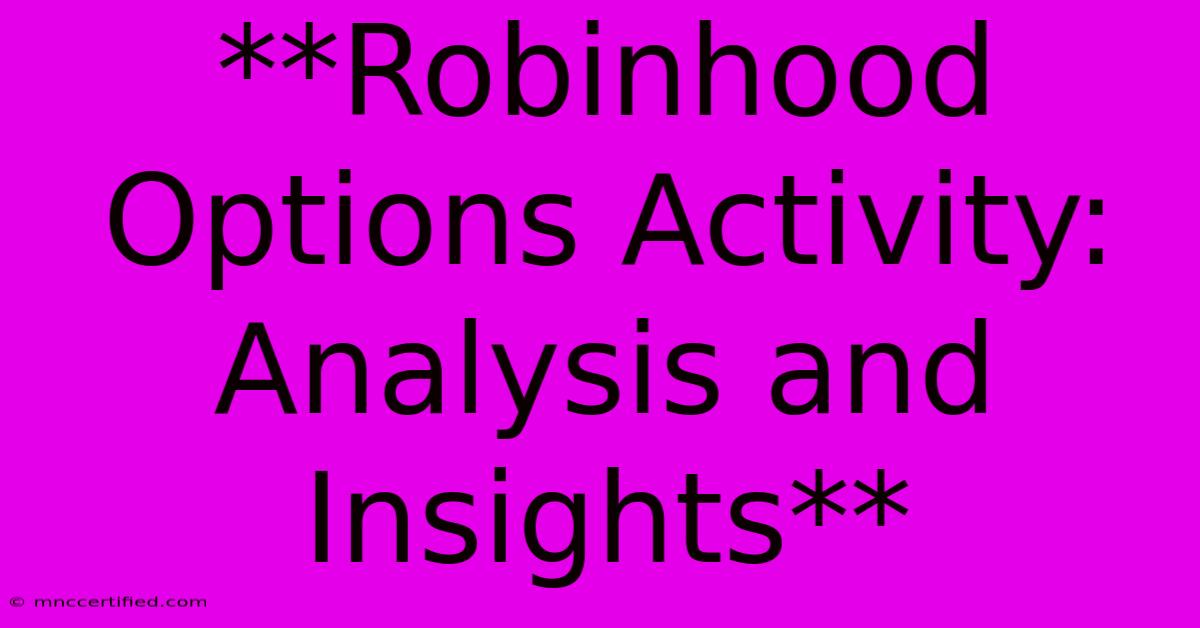**Robinhood Options Activity: Analysis And Insights**

Table of Contents
Robinhood Options Activity: Analysis and Insights
Robinhood, the popular mobile investing platform, has become synonymous with retail trading, particularly options trading. The platform's user-friendly interface and commission-free structure have attracted millions of investors, many of whom are new to the world of options. But what does Robinhood's options activity tell us about the market and the behavior of retail investors? This article will delve into analyzing Robinhood options data and uncovering valuable insights.
Robinhood Options Data: A Window into Retail Sentiment
Robinhood's options activity provides a glimpse into the sentiment and trading behavior of retail investors. By analyzing the platform's most popular options contracts, we can gain insights into:
- Popular Stocks: Identifying the stocks with the highest options volume reveals the companies that are attracting the most attention from Robinhood users. This can be an indicator of upcoming price movements, as retail investors often drive momentum in certain stocks.
- Bullish or Bearish Sentiment: The ratio of call options (bets on a stock price increase) to put options (bets on a stock price decrease) can signal the overall sentiment among Robinhood traders. A high call-to-put ratio suggests a bullish outlook, while a low ratio indicates bearish sentiment.
- Volatility Expectations: The price of options contracts reflects the market's expectations for future price volatility. High option prices suggest investors anticipate significant price swings in the underlying stock, while lower prices signal a more stable outlook.
Analyzing Robinhood Options Data: Tools and Resources
Several resources allow you to analyze Robinhood's options activity:
- Robinhood's own website: The platform offers limited data on its website, including the most popular options contracts traded on a given day. However, this data is insufficient for a comprehensive analysis.
- Third-party data providers: Several companies specialize in providing detailed options data from various platforms, including Robinhood. These providers offer valuable tools and insights for analyzing retail investor sentiment.
- Social media platforms: Monitoring social media discussions and forums related to Robinhood and options trading can provide valuable insights into the latest trends and market sentiment.
Caveats and Limitations of Robinhood Options Data
While Robinhood options data can offer valuable insights, it's crucial to remember its limitations:
- Limited data: Robinhood only provides limited data publicly, making it challenging to get a complete picture.
- Retail bias: Robinhood data reflects the behavior of retail investors, which may not be representative of the overall market.
- Potential manipulation: The data can be manipulated for promotional purposes or to influence market sentiment.
How to Use Robinhood Options Data Wisely
While analyzing Robinhood options data can be informative, it's crucial to use it responsibly:
- Combine with other data: Don't rely solely on Robinhood data. Combine it with other market indicators and fundamental analysis to make informed trading decisions.
- Understand the context: Consider the overall market conditions, company news, and other relevant factors when interpreting Robinhood options data.
- Don't blindly follow the crowd: Remember that retail investors can sometimes be wrong, and following the crowd blindly can lead to losses.
Conclusion: A Valuable Tool for Market Insight
Robinhood options activity provides a valuable window into the sentiment and behavior of retail investors. By understanding the platform's data, investors can gain insights into market trends and potential price movements. However, it's crucial to use this information cautiously, considering its limitations and combining it with other data sources.
Keywords: Robinhood, options, trading, retail investors, market sentiment, volatility, data analysis, insights, tools, limitations, strategy

Thank you for visiting our website wich cover about **Robinhood Options Activity: Analysis And Insights** . We hope the information provided has been useful to you. Feel free to contact us if you have any questions or need further assistance. See you next time and dont miss to bookmark.
Featured Posts
-
Thank You For Investing In My Future
Nov 12, 2024
-
Kevin Costner Exits Yellowstone
Nov 12, 2024
-
Unit 6 Chemical Bonding Test Review
Nov 12, 2024
-
Jcpenney Life Insurance Transamerica
Nov 12, 2024
-
Guilty Verdict In Delphi Murders Case
Nov 12, 2024